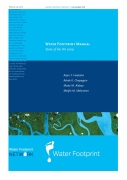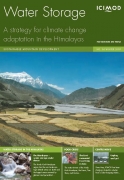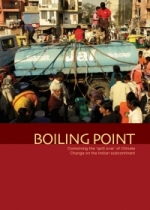Climate and Weather
Making climate look like trade? - Questions on incentives, flexibility and credibility - A policy brief by Centre for Policy Research
Posted on 14 Apr, 2010 06:48 PMThe policy brief published by the Centre for Policy Research (CPR), India addresses the debates around climate change that took place before and after the Copenhagen Climate Conference (2009) that raised a number of questions regarding the architecture of the global climate regime.
Climate change threats to India's water resources and emerging policy responses - From the book 'Indian climate policy: Choices and challenges', by the Henry Stimson Centre.
Posted on 14 Apr, 2010 11:01 AMThis book published by Henry L. Stimson Centre highlights the richly diverse nature of India's views on climate change through its range of essays. These essays demonstrate and challenge the international perception of India as a monolithic actor with a single set of opinions and views in the climate change negotiations.
In this chapter, the author discusses the strengths and the weaknesses of India's climate policy in the context of the increasing threats that have been identified to the water resources in the country. The author states that India's climate policy is still in its emerging state and argues that though the policy does highlight many important areas related to climate change, it does not give adequate attention to a very crucial area of water management.
Water Footprint Manual: State of the art - A method of water footprint assessment by the Water Footprint Network (November 2009)
Posted on 11 Apr, 2010 07:37 PM The Water Footprint Manual (2009) by the Water Footprint Network (WFN) is a comprehensive and up-to-date outline of the method of water footprint assessment. It introduces how water footprints can be calculated for individual processes and products, as well as for consumers, nations and businesses.
The Water Footprint Manual (2009) by the Water Footprint Network (WFN) is a comprehensive and up-to-date outline of the method of water footprint assessment. It introduces how water footprints can be calculated for individual processes and products, as well as for consumers, nations and businesses.
The concept is introduced as a comprehensive indicator of freshwater resources appropriation, as against the traditional and restricted measure of water withdrawal. The hidden water use behind products are measured over the full supply chain and water consumption volumes are measured by source and polluted volumes by type of pollution. All components of a total water footprint are specified geographically and temporally. Blue water (surface and groundwater), green water (rainwater stored in the soil as soil moisture) and grey water (polluted water) footprints are defined and are included along with the indirect water use in measuring the overall water footprints.
Climate change impacts in drought and flood-affected Areas: Case studies in India - A report by the World Bank
Posted on 11 Apr, 2010 03:50 PMThis report by the World Bank discusses the climate changes in India and the disasters associated with these climate changes such as floods and droughts and their negative impact on agriculture, food production, livelihoods, security and the condition of the vulnerable groups in the country. The report goes on to discuss the policies undertaken by the Government of India to deal and adapt with these changes and the challenges faced in implementing these policies.
Water Storage: A strategy for climate change adaptation in the Himalayas - A report by ICIMOD
Posted on 10 Apr, 2010 05:24 PM This report by the International Centre for Integrated Mountain Development (ICIMOD) highlights the phenomenon of climate change and argues that water storage will be a key strategy for climate change adaptation in the coming years.
This report by the International Centre for Integrated Mountain Development (ICIMOD) highlights the phenomenon of climate change and argues that water storage will be a key strategy for climate change adaptation in the coming years.
The report discusses the importance of the Hindu Kush Himalayan ranges as an important source of water to a large section of the population and warns of the impending crisis of water scarcity and food insecurity in the regions of Asia, if water harvesting and conservation efforts are not undertaken. The document argues that water storage thus becomes a central issue, which is very complicated to implement, particularly in the Hindu Kush Himalayan region.
An ecological framework for water management in a domestic context - A spreadsheet-based toolkit by Biome
Posted on 08 Apr, 2010 10:43 PMBased on user-entered data on domestic water demand, waste water discharge, rainfall availability and recharge, extent of reuse of treated waste water, this spreadsheet-based toolkit developed by Biome Solutions allows you to juggle around with the relevant data fields, and figure out various ways in which you can bring down your overall groundwater draft (and hence ecological footprint) as low as possible, and gives a snapshot result of your overall household-level water input and output situation.
Boiling Point: Containing the spill over of climate change in the Indian subcontinent - A report by Sustainable Environment and Ecological Development Society (SEEDS)
Posted on 08 Apr, 2010 02:07 PM The report ‘Boiling Point’ by Sustainable Environment and Ecological Development Society (SEEDS) discusses the impact of climatic changes at the global, national and local level on the environment and on the current survival, food, water security issues and livelihoods of communities in India.
The report ‘Boiling Point’ by Sustainable Environment and Ecological Development Society (SEEDS) discusses the impact of climatic changes at the global, national and local level on the environment and on the current survival, food, water security issues and livelihoods of communities in India.
The report highlights the problems faced by a number of communities from the different parts of the country by presenting case studies that describe how climatic changes have influenced local livelihoods and survival needs of communities with the marginalised and the deprived being the most affected. The report presents a few case studies that illustrate how people have coped with these problems by finding out appropriate, locally relevant and sustainable solutions.
The report recognises that identification of positive efforts made by individuals or groups of people through the case studies can be one such step towards triggering a discussion and educating the people on the seriousness of the situation and making them realise of the urgency to act fast. The report identifies the need for advocacy and educational efforts based on the bottom up approach involving the grassroot level that can lead to building up of pressure for the need to bring about changes at the policy level.
National Conference on Climate Change and Agriculture - "Ensuring Food Security in a changing climate", Gene Campaign and Action Aid
Posted on 02 Apr, 2010 04:34 PMOrganizer:Gene Campaign and Action Aid
Venue: New Delhi
Topic:Ensuring Food Security in a Changing Climate
Despcription:
Using dried wells to enrich deep level under ground water pockets
Posted on 31 Mar, 2010 02:45 PMBy using dried open wells, we can enrich the Underground water quickly.
In the good old days, open wells used to help the common man in fetching water for all purposes and specially the drinking water. Invasion of pump-sets and specially the deep bore wells have pulled the underground water indiscriminately. Therefore, the water table level of the underground water is continuously going down at a very alarming rate. This fall in the underground water table level has made many a very big and useful water wells dry up. Now they are not in use as people do depend on alternative source of water like bore well water or the tap water drawn from far off river water.
Parvatiya Jal Utsav Mountain Water Festival, Himachal Pradesh
Posted on 09 Mar, 2010 04:38 PMVenue:Himachal Pradesh





